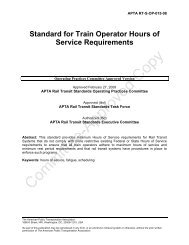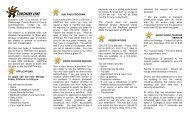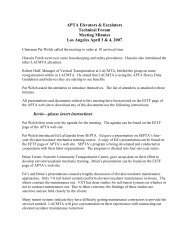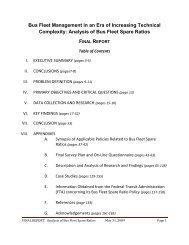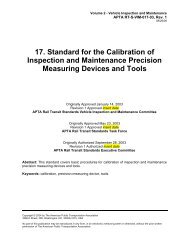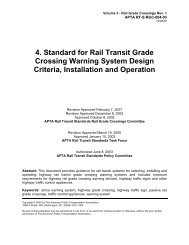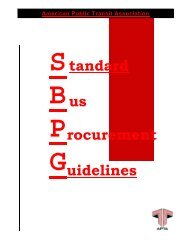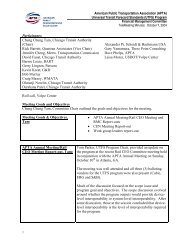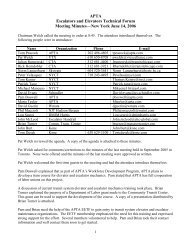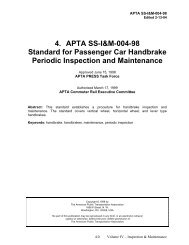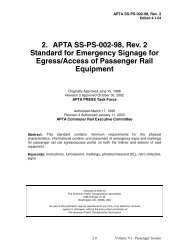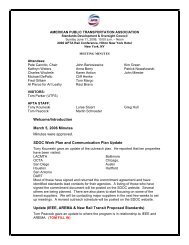Table of Contents - APTAStandards.com
Table of Contents - APTAStandards.com
Table of Contents - APTAStandards.com
Create successful ePaper yourself
Turn your PDF publications into a flip-book with our unique Google optimized e-Paper software.
These standards and specifications were subjected to detailed analysis in order to assess<br />
their level <strong>of</strong> applicability to UTFS WP4 efforts. The established criteria for the level <strong>of</strong><br />
applicability were developed based on the input from the APTA Financial Committee’s<br />
Interface<br />
Specification Functional Description and Booz Allen’s experience in<br />
implementing regional fare payment systems.<br />
The criteria included:<br />
• Common Message Structure that is supported by all data exchange<br />
• Message Types that are applicable to UTFS WP4 proposed messages<br />
• Data Elements that are specific to the transit industry<br />
• Message Sequences that support an organized flow <strong>of</strong> data<br />
• Security Requirements to allow for the protection <strong>of</strong> sensitive transit data and the<br />
fiscal integrity <strong>of</strong> the larger payments scheme implemented for all participant in a<br />
region<br />
• Timing and Routing that dictates the operational requirements <strong>of</strong> the system<br />
• Usability <strong>of</strong> the standard or specification by APTA<br />
The following sections include the detailed analysis for each <strong>of</strong> the standards<br />
and<br />
specifications listed in the Exhibit 4-1.<br />
4.1 ISO/IEC 8583<br />
4.1.1 Description <strong>of</strong> the Standard<br />
ISO/IEC<br />
8583 is designed as an interface standard enabling messages to be exchanged<br />
between systems that employ different application specifications. This standard <strong>of</strong>fers<br />
application designers freedom from overall design<br />
constraints because messages can be<br />
converted<br />
to the format <strong>of</strong> this interface for international interchange to take place.<br />
This international standard uses a concept called bitmap, whereby each data element is<br />
assigned a pos ition indicator in a control field (or bitma p). A “1” in the assigned<br />
position indicates the presence <strong>of</strong> a data element in a specific message, and a “0” in the<br />
assigned<br />
position, indicates the absence <strong>of</strong> a data element. This will allow application<br />
designers to choose variable length data elements and messages, and the flexibility to<br />
utilize data element types that are best suited for a specific application.<br />
The standard is designed to<br />
ac<strong>com</strong>modate real-time “request-response,” and batch and<br />
file<br />
transfer type information exchange. It can also be utilized for both peer-to-peer and<br />
centralized settlement schemes due to its flexible design.<br />
ISO/IEC 8583 specifies a well-defined message structure, and message format and<br />
content.<br />
It is widely used in the financial industry, particularly in the handling <strong>of</strong> all<br />
credit and debit card transactions among financial institutions and merchants around<br />
the world.<br />
Page 13



